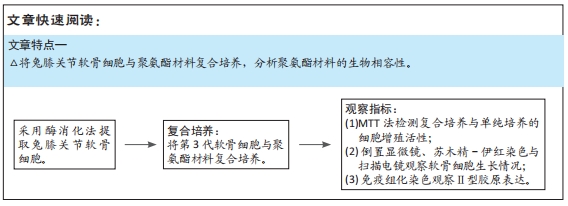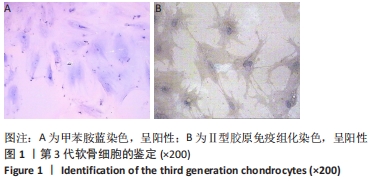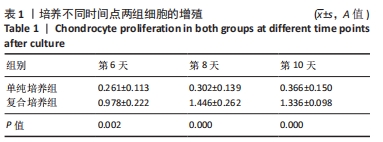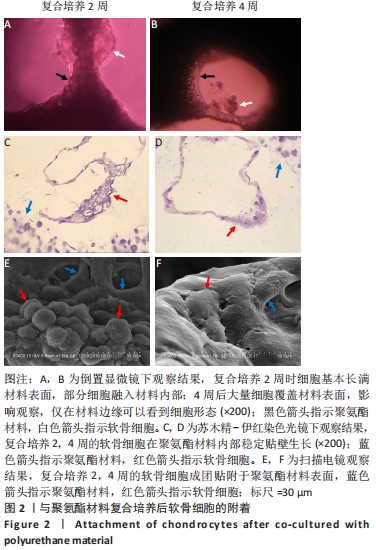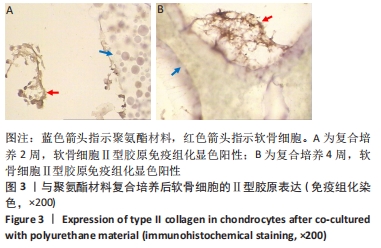[1] DAMERAU A, PFEIFFENBERGER M, WEBER MC, et al. A Human Osteochondral Tissue Model Mimicking Cytokine-Induced Key Features of Arthritis In Vitro. Int J Mol Sci. 2020;22(1):128.
[2] CHEN G, KAWAZOE N. Porous Scaffolds for Regeneration of Cartilage, Bone and Osteochondral Tissue. Adv Exp Med Biol. 2018;1058:171-191.
[3] HIGA K, KITAMURA N, GOTO K, et al. Effects of osteochondral defect size on cartilage regeneration using a double-network hydrogel. BMC Musculoskelet Disord. 2017;18(1):210.
[4] SMITH BT, SANTORO M, GROSFELD EC, et al. Incorporation of fast dissolving glucose porogens into an injectable calcium phosphate cement for bone tissue engineering. Acta Biomater. 2017;50:68-77.
[5] BERNSTEIN JL, COHEN BP, LIN A, et al. Tissue Engineering Auricular Cartilage Using Late Passage Human Auricular Chondrocytes. Ann Plast Surg. 2018;80(4 Suppl 4):S168-S173.
[6] CHRISTENSEN BB. Autologous tissue transplantations for osteochondral repair. Dan Med J. 2016;63(4):B5236.
[7] SCHMIDT TA, SCHUMACHER BL, KLEIN TJ, et al. Synthesis of proteoglycan 4 by chondrocyte subpopulations in cartilage explants, monolayer cultures, and resurfaced cartilage cultures. Arthritis Rheum. 2004;50(9):2849-2857.
[8] XU J, ZHANG C. In vitro isolation and cultivation of human chondrocytes for osteoarthritis renovation. In Vitro Cell Dev Biol Anim. 2014;50(7):623-629.
[9] YANG X, LIU S, LI S, et al. Salvianolic acid B regulates gene expression and promotes cell viability in chondrocytes. J Cell Mol Med. 2017;21(9):1835-1847.
[10] 田峰,崔学生,张帅,等.改良分布消化法培养原代软骨细胞[J].中国组织工程研究与临床康复,2011,15(20):3633-3635.
[11] JEON OH, WILSON DR, CLEMENT CC, et al. Senescence cell-associated extracellular vesicles serve as osteoarthritis disease and therapeutic markers. JCI Insight. 2019;4(7):e125019.
[12] O’BRIEN K, TAILOR P, LEONARD C, et al. Enumeration and Localization of Mesenchymal Progenitor Cells and Macrophages in Synovium from Normal Individuals and Patients with Pre-Osteoarthritis or Clinically Diagnosed Osteoarthritis. Int J Mol Sci. 2017;18(4):774.
[13] SILVERWOOD V, BLAGOJEVIC-BUCKNALL M, JINKS C, et al. Current evidence on risk factors for knee osteoarthritis in older adults: a systematic review and meta-analysis. Osteoarthritis Cartilage. 2015;23(4):507-515.
[14] ROCHA TC, RAMOS PDS, DIAS AG, et al. The Effects of Physical Exercise on Pain Management in Patients with Knee Osteoarthritis: A Systematic Review with Metanalysis. Rev Bras Ortop (Sao Paulo). 2020;55(5):509-517.
[15] BANNURU RR, OSANI MC, VAYSBROT EE, et al. OARSI guidelines for the non-surgical management of knee, hip, and polyarticular osteoarthritis. Osteoarthritis Cartilage. 2019;27(11):1578-1589.
[16] 江海良,夏青,魏振,等.携带人胰岛素样生长因子I基因的重组腺病毒体外转导培养关节软骨细胞[J].中国组织工程研究与临床康复,2008,12(24):345-347.
[17] LI Q, HAN B, WANG C, et al. Mediation of Cartilage Matrix Degeneration and Fibrillation by Decorin in Post-traumatic Osteoarthritis. Arthritis Rheumatol. 2020;72(8):1266-1277.
[18] JIANG S, GUO W, TIAN G, et al. Clinical Application Status of Articular Cartilage Regeneration Techniques: Tissue-Engineered Cartilage Brings New Hope. Stem Cells Int. 2020;2020:5690252.
[19] 刘亚东.PGS-PCL多孔支架复合骨髓间充质干细胞修复关节软骨损伤的实验研究[D].大连:大连医科大学,2019:10.
[20] SUN Y, YOU Y, JIANG W, et al. 3D-bioprinting a genetically inspired cartilage scaffold with GDF5-conjugated BMSC-laden hydrogel and polymer for cartilage repair. Theranostics. 2019;9(23):6949-6961.
[21] MUNIR N, MCDONALD A, CALLANAN A. Integrational Technologies for the Development of Three-Dimensional Scaffolds as Platforms in Cartilage Tissue Engineering. ACS Omega. 2020;5(22):12623-12636.
[22] MANAVITEHRANI I, FATHI A, BADR H, et al. Biomedical Applications of Biodegradable Polyesters. Polymers (Basel). 2016;8(1):20.
[23] CAMPOS Y, ALMIRALL A, FUENTES G, et al. Tissue Engineering: An Alternative to Repair Cartilage. Tissue Eng Part B Rev. 2019;25(4):357-373.
[24] DA L, GONG M, CHEN A, et al. Composite elastomeric polyurethane scaffolds incorporating small intestinal submucosa for soft tissue engineering. Acta Biomater. 2017;59:45-57.
[25] RONG J, POOL B, ZHU M, et al. Basic Calcium Phosphate Crystals Induce Osteoarthritis-Associated Changes in Phenotype Markers in Primary Human Chondrocytes by a Calcium/Calmodulin Kinase 2-Dependent Mechanism. Calcif Tissue Int. 2019;104(3):331-343.
[26] BERGMEISTER H, SEYIDOVA N, SCHREIBER C, et al. Biodegradable, thermoplastic polyurethane grafts for small diameter vascular replacements. Acta Biomater. 2015;11:104-113.
[27] JIANG H, CUI Y, MA K, et al. Experimental reconstruction of cervical esophageal defect with artificial esophagus made of polyurethane in a dog model. Dis Esophagus. 2016;29(1):62-69.
[28] HUBKA KM, DAHLIN RL, MERETOJA VV, et al. Enhancing chondrogenic phenotype for cartilage tissue engineering: monoculture and coculture of articular chondrocytes and mesenchymal stem cells. Tissue Eng Part B Rev. 2014;20(6):641-654.
[29] KANG N, LIU X, CAO Y, et al. Comparison study of tissue engineered cartilage constructed with chondrocytes derived from porcine auricular and articular cartilage. Zhonghua Zheng Xing Wai Ke Za Zhi. 2014;30(1):33-40.
[30] KRAJEWSKA-WŁODARCZYK M, OWCZARCZYK-SACZONEK A, PLACEK W, et al. Articular Cartilage Aging-Potential Regenerative Capacities of Cell Manipulation and Stem Cell Therapy. Int J Mol Sci. 2018;19(2):623.
[31] BERNSTEIN JL, COHEN BP, LIN A, et al. Tissue Engineering Auricular Cartilage Using Late Passage Human Auricular Chondrocytes. Ann Plast Surg. 2018;80(4 Suppl 4):S168-S173.
[32] CHEN X, FAN H, DENG X, et al. Scaffold Structural Microenvironmental Cues to Guide Tissue Regeneration in Bone Tissue Applications. Nanomaterials (Basel). 2018;8(11):960.
|
